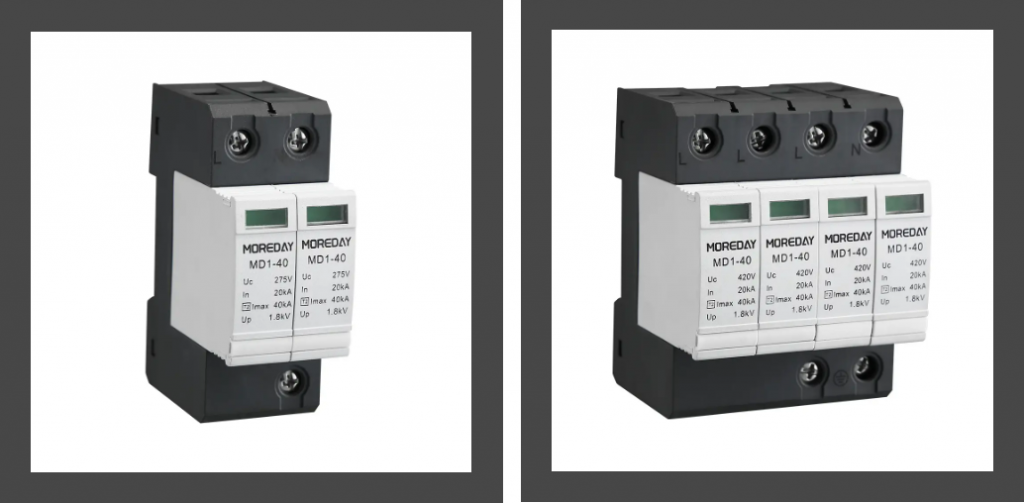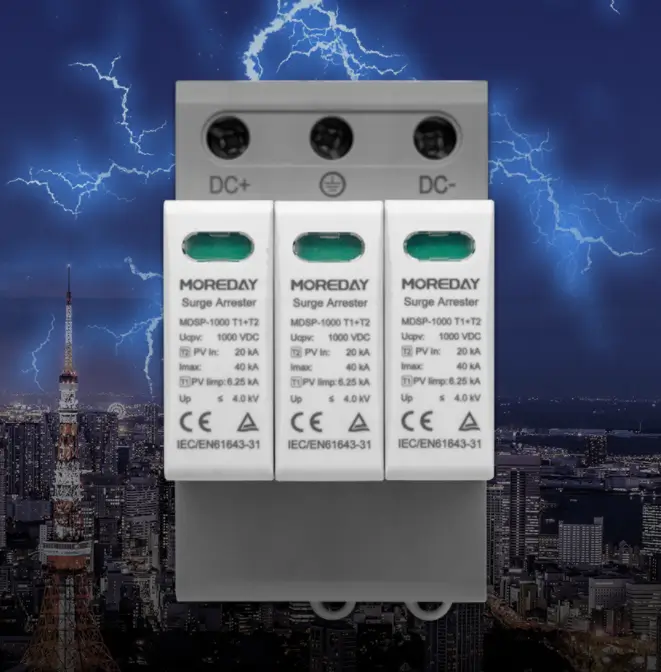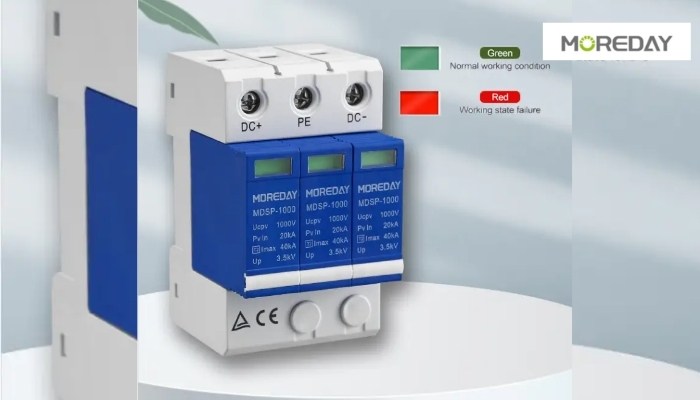A surge protector device (SPD) is an important protective device for your electrical equipment against sudden voltage spikes. These spikes, often caused by lightning strikes, power outages, or other electrical disturbances, can seriously damage your equipment.
By installing an SPD, you can create a barrier that limits voltage to safe levels, ensuring that your electronic equipment is not damaged.
In this introduction, we’ll explore the function, importance, and application of surge protection devices and how they can help create a safer, more reliable electrical infrastructure.
What Is a Surge Protection Device?

A Surge Protection Device (SPD) is a device used to protect electrical equipment from damage caused by transient voltage excesses, known as surges. It protects connected equipment from damage by quickly directing excessive voltage to the ground in the event of a lightning strike, power switch operation, or other sudden voltage increase in the power grid.
Surge protection devices are widely used in domestic, commercial, and industrial electrical systems to ensure the safe operation of electronic equipment and circuits.
Types of Surge Protective Devices
1. Type 1 Surge Protective Device
A Type 1 surge protection device is installed directly at the main switchboard of a building and is typically used to prevent high-energy voltage surges caused directly or indirectly by lightning strikes from entering the building’s electrical system.
It is primarily used at the main power input of a building and is capable of withstanding very high surge currents and directing them to the ground.
Features:
- Able to cope with high current surges caused by lightning
- Installed at the entrance to the electrical distribution system, usually in a distribution cabinet
- Provides initial surge protection for the entire building’s electrical system
2. Type 2 Surge Protective Device
A Type 2 surge protection device is installed in the downstream portion of the switchboard or in each electrical branch circuit. It serves to further limit voltage surges that are missed by the primary surge protection device and ensures the safety of electrical equipment in the building.
The Type 2 SPD reduces smaller surges caused by lightning strikes or internal electrical operations and protects sensitive equipment.
Features:
- Primarily used in secondary switchboards, commonly found in commercial and residential environments
- Reduces surge current that has already passed through the primary protective device
- Ideal for protecting internal equipment from lower-intensity surges.
3. Type 3 Surge Protective Devices
Type 3 Surge Protective Devices are typically installed close to electronic equipment, such as outlets, wall distribution boxes, or near terminal equipment.
They deal with very small voltage surges, usually residual surges that are not fully eliminated by Type 1 and Type 2 surge protectors. Type 3 SPDs provide equipment-level protection and are the last line of defense in protecting sensitive electronic equipment.
Features:
- Mounts on the front of the device or at the outlet
- Handles small residual voltage surges and protects the final electronic device
- Ideal for protecting sensitive equipment such as household appliances, computers, televisions, etc.
These different types of surge protection devices play different roles throughout the electrical system and are often used in conjunction to provide layered surge protection to ensure safe operation from the building’s electrical inlet to the end equipment.
How Surge Protection Devices Work
The principle of operation of a surge protection device is that by monitoring the voltage level in the power system in real-time, when a transient voltage rises (i.e., a surge) is detected, it will quickly shunt the excess voltage and direct it to the ground, protecting the equipment from overvoltage damage.
Common surge protection components such as metal oxide varistors (MOVs) or gas discharge tubes (GDTs) are in a high-resistance state at normal voltages, and once the voltage exceeds the safe range, the impedance of the component rapidly decreases, dispersing the surge energy and preventing equipment damage.
Once the surge is over, the surge protection device will return to a high resistance state and continue to monitor the system voltage level. Through this repeated protection and recovery mechanism, surge protection devices can effectively prevent transient voltage fluctuations triggered by lightning strikes, power switching, or other electrical anomalies, and safeguard the safe operation of electrical equipment.
How Do I Select a Surge Protection Device?

When selecting a surge protection device, the following key factors need to be considered to ensure that it can effectively protect the equipment and meet the system requirements:
1. Protection Class (Type 1, Type 2, Type 3)
Choose the appropriate level according to the application scenario of the lightning arrester. Type 1 is used to protect the power entrance of the building, mainly to prevent lightning strikes. Type 2 is used in the distribution board to prevent surges inside the equipment.
Type 3 is installed at the front end of the equipment or at the socket to protect the terminal equipment. Usually, a combination of multiple levels of lightning arresters is required to achieve layered protection.
2. Voltage Rating and Maximum Discharge Current (Ka Value)
When selecting a surge protection device, it is important to ensure that it is capable of withstanding the system voltage and handling the maximum surge current that may occur. The maximum discharge current capability of a device is usually expressed in kA. For home or office environments, 20kA to 40kA surge protection devices are usually sufficient, while industrial environments may require higher kA values.
3. Response Time
The response time of a surge protection device is the time interval between when it detects a surge and when it protects against it, usually measured in nanoseconds (ns). The faster the response time, the more effective the device is at protecting the equipment. Ideally, a surge protection device should have a fast response time of less than 1 nanosecond to ensure that the equipment is protected from transient voltage shocks.
4. Installation Location and Compatibility
Depending on the type and location of the equipment to be protected, choose the surge protection device suitable for installation.
For example, for home outlets or office equipment, you can choose the socket type surge protector, while the power distribution system requires a larger capacity. In addition, make sure that the surge protection device is compatible with existing electrical systems and equipment.
5. Surge Protection Device Price
Price is also an important factor when choosing a surge protection device. Generally speaking, Type 1 surge protection devices are more expensive and apply to the protection of the whole building, which may range from several hundred to thousands of dollars. Type 2 applies to the distribution of electrical panels, and the price is usually around a few hundred dollars.
Type 3 end-device protection devices, such as socket-type surge protectors, are less expensive and can cost tens to hundreds of dollars. When choosing, the decision needs to be based on the protection needs and budget to ensure that the equipment is properly protected.
Comprehensive consideration of the above factors, combined with the budget, equipment requirements, and the installation environment, the selection of appropriate surge protection devices can effectively enhance the safety of the electrical system and protect critical equipment from surge damage.
Can I Wholesale These Surge Protectors?
Yes, you can wholesale surge protectors. Many manufacturers and suppliers offer wholesale options such as MOREDY They are not only able to wholesale these products in large orders. They also support individual purchases to meet the specific needs of some customers.
If you are planning to purchase wholesale, you can contact the MOREDY manufacturer of surge protectors directly to inquire about wholesale discounts, minimum order quantities, and lead times. Wholesale purchases can get better price discounts and after-sales service, which is suitable for projects that need to be used in large quantities or for long-term supply business. Contact us for a precise quote!
Conclusion
In conclusion, surge protection devices are essential for protecting your electronic devices and electrical systems from unexpected voltage spikes. By choosing the right type of SPD, whether it’s for whole building protection, internal circuits, or individual devices, you can ensure long-term safety and efficiency.
Investing in these protective devices will not only help extend the life of your equipment but also minimize costly downtime and potential damage. Consider your specific needs before choosing and selecting the most appropriate surge protector to maintain a stable and safe electrical environment.
Related reading: How to Size Surge Protection Device?


